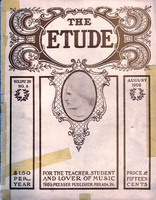In response to numerous questions relative to the classification of organ-stops we quote the following from that excellent work, “Organ Construction,” by J. W. Hinton, M.A. Mus. Doc.:
By the term “stop” is meant a number of pipes following each other chromatically, and extending over the full compass of the keyboard, or some portion thereof only. Each set, or series, of pipes thus situated is composed of tubes of the same construction producing the same quality of tone throughout; and—as there is a pipe (or sound-producer) to every key—the series aforesaid constitutes a complete instrument or stop. When two stop-handles are drawn there are two instruments simultaneously controllable from the keys, just as would be the case if it were possible to unite two pianos in such a manner that they could be simultaneously played by one performed on one keyboard.
The German term Stimme (or voice) for Stop is an excellent one, as the organist must consider that he is virtually directing a chorus, each stop being a unit. If he draw one, it is as though he told an individual to sing alone; if he draw two or three, it is the same as though he told two or three persons to sing in unison.
I certainly think that all separate series of pipes should be termed “voices,” according to the German precedent. To call each voice or instrument a Stop is as unphilosophical as to call it a wind-tap, or stop-cock; it only describes a portion of the mechanism necessary to secure the independent action of the “voice” in question.
From an etymological point of view it is, however, quite easy to account for the word “stop.” Until about the middle of the fifteenth century each key in an organ controlled a certain pre-arranged number of pipes; in fact, the organ was simply a huge “mixture,” sometimes having forty or fifty ranks. When means were devised by which the player could stop certain ranks from sounding, thus isolating others he wished to use alone, a new era dawned in the annals of organ-building. The term “stop” recalls the fact that sliders were first used rather to silence ranks of pipes than to bring them on, and, in itself, constitutes a record of the causes which led to its invention. Similarly the term “barrel” applied to the body of a gun, reminds us that gun-barrels used to be made of wooden staves hooped together like a cask.
Stops (to use the accepted term) are thus classified:
I. Complete stops.
II. Incomplete stops.
III. Short stops.
IV. Divided stops.
V. Compound stops.
Complete stops are those which extend throughout the entire compass of the manual keyboard or pedal clavier.
Incomplete stops are stops which, while usually made of complete compass, may, in particular cases, be found commencing at some point above the usual one, thus lacking some low notes.
Short stops are virtually the same; but such must not be termed incomplete, seeing that they cannot be legitimately completed.
Nearly all orchestral or imitative stops, which are called by the name of an instrument, are incomplete. No orchestral instrument has five octaves of compass, as the organ clavier has; for example: the Flute has no bass, nor yet the Oboe, when treated orchestrally. But Oboe treble and Bassoon base are often conventionally grouped into one, under the name of Oboe, just as Violin and Violoncello are combined under the name of Gamba.
Divided stops are stops drawn in two portions by two stop-handles, one producing the acute, and the other the grave, portion of the same series of pipes.
This form of divided stop is not common in modern organs; but where there are incomplete stops the costly lower notes which they lack are usually supplied by an independent set of closed wooden pipes, which can be drawn to complete any one of the incomplete stops, and is termed Stopped Bass.
Compound stops are those which have two or more pipes to each note: i.e., two or more complete series of pipes are brought on simultaneously.
The pipes of which stops are composed are thus classified:
I. Flue pipes.
II. Reed pipes.
Flue pipes—virtually whistles of various shapes— are subdivided into:
Open pipes: i.e., those having their upper end open.
Stopped pipes: i.e., those in which that end is closed.
Reed pipes—provided with vibrating tongues—are subdivided into Beating reeds and Free reeds. In beating reeds the tongue beats against the reed; in free reeds it beats between the sides of a slot or groove in the reed and does not touch anything.



